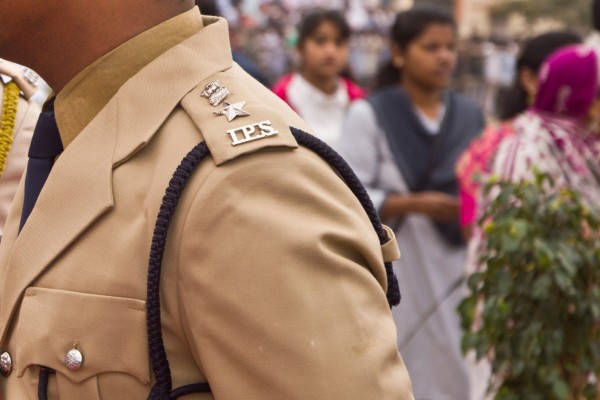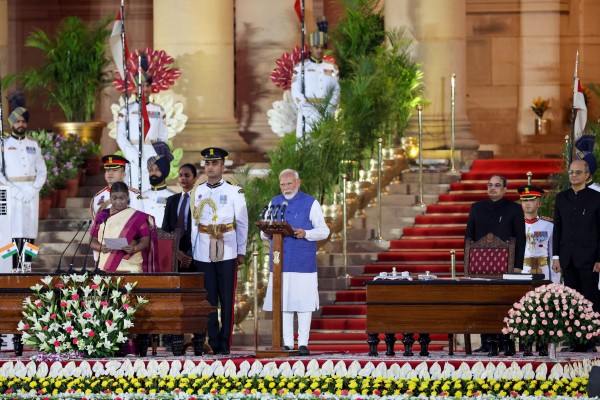Autumn 2010 has been a season of political storms in India, and the media finds itself in the midst of a controversy, with its role and ethics under public scrutiny. In the centre of it all is a massive corruption scandal over the allocation of radio frequency spectrum to mobile telephone operators at 2001 prices in 2008 leading to windfall gains to the telephone companies and a corresponding loss to the exchequer that the government’s auditor estimates at between $12.8 and 39.3 billion.
Evidence of the wrongdoing had been surfacing in the media since April of this year, but it was only in November that it became a full-fledged political scandal when recorded telephone conversations came to be placed in the public domain showing how a lobbyist, businessmen, political officials and civil servants sought to influence public policy to the advantage of a few telephone companies. The immediate fallout from this has been a crippling of the polity. It has seen, among other things, an investigation of corruption by the federal investigative agency, the Central Bureau of Investigation (CBI); a petition in the highest court of the country, the Supreme Court, alleging a massive cover up and that the investigation was being conducted in a non-serious manner; the resignation of the minister for telecommunications and raids and seizures of documents from his house; and a paralysis of parliament over the demand of the opposition parties for a special committee to investigate the scandal that the government is unwilling to accept.
Suspecting a massive tax fraud including the flow of unaccounted money from the underground or black economy out of the country, typically to Mauritius, and coming back as “foreign investment,” the income tax department, after obtaining authorisation from the home secretary, tapped the telephones of a lobbyist, Niira Radia, and her associates over two periods from September to December 2008 and again from May to July 2009. In all, over 5000 conversations were recorded that indicated tax fraud and how the lobbyist and her associates “not only manage the media but as per conversations apparently try to influence policy decisions of various government departments to suit the commercial requirements of their clients,” as the income tax department put it. The department handed an analysis of the conclusions it could draw from the conversations and the recordings themselves to the CBI after it took up investigation of the spectrum allocation case in October, 2009.
News about the tapes and what they reveal was published in the Pioneer newspaper in April of this year but the issue came to the fore after two national publications, Open magazine and Outlook magazine, placed the recordings of 140 of the conversations on their website. In this company of the lobbyist, her associates, businessmen and political officials figure over 15 journalists, including some well-known names, and their conversations open a fascinating window to the high pressure management of the media. Almost all the journalists involved come out of it with their independence seemingly compromised.
It is not clear though that only those journalists who figure in the tapes alone must be judged harshly, and two caveats need to be entered. What we have now are the conversations of some 15 journalists and worse things could have happened elsewhere that we do not know anything about as of now. Secondly, there is no talk or even a hint of any money changing hands or any other form of overt corruption, which would be some consolation if one were to set the bar low. The absence of any talk in the tapes indicating corruption does not, however, mean that corrupt practices did not occur.
When the tapes of the journalists’ conversations came into the public domain, the media dealt with the issue in varied ways. A few publications and television networks covered the original spectrum allocation scandal and the journalists’ tapes with equal rigour. Others who covered the spectrum scandal rigorously kept off the issue of journalists altogether, perhaps because they were connected with the particular organisation or over doubts about the tapes themselves. A handful who were soft in dealing with the broader spectrum issue were harsh on the journalists.
The question was also raised whether any of the tapes should have been placed in the public domain by the two magazines. One of the country’s leading industrialists, Ratan Tata, said it was a breach of his privacy and voyeuristic to have published his telephone conversations that were recorded for the specific purpose of a tax enquiry and could not be used for any other purpose. That the recordings by a government agency was leaked was in itself regarded as objectionable and prompted an enquiry by the government into the source of the leaks.
Two separate though related issues were being raised here: the issue of leaks from within the government that was really an administrative problem and the propriety of the publications that obtained the recordings to have published them. So far as publication was concerned, clearly an overriding public interest was involved in the issue of spectrum allocation and the resultant loss to the government. And almost the whole of the conversations, except for minor snatches that related to gossip about third parties or to personal small talk, touched on public policy issues such as the pricing of gas and government formation. If the lobbyist and her work were unorthodox and tainted inputs that went into the shaping of public policy, the public had the right to know about them.
A related issue raised by some, including the journalists involved, was whether it was fair journalism to have published the tapes before talking to those who figured in them and getting their side of the story. The two magazines pointed out that in this breaking story they were seriously constrained by time and in any case the versions of the journalists involved were published very soon after. It was also significant that the authenticity of the recordings was not denied by any of those involved. It was argued with some justification that in a sensitive story of this type the contents could not have been revealed to anyone without alerting all the players involved and risking legal and other attempts to stop publication. Journalists by the very nature of their profession stand for openness and the right to information from public authorities and there is something incongruous in claiming the right to privacy when their own professional conduct was involved. Their professional conduct even in their unguarded moments should ideally stand the test of public scrutiny and it is this test that most of the journalists involved failed. In the general perception that came through repeatedly in reactions to the publication, journalists had failed to meet the standards that they demanded very often of public officials.
The conversations raise several questions of media ethics, among them the dirty hands problem: could political journalists use lobbyists as legitimate news sources and avoid compromising their integrity and independence. The issue is complicated by the fact that lobbyists move seamlessly among politicians, businessmen, civil servants and the media and their inputs go into the shaping of public policy. In a milieu where appearances and public pronouncements could be misleading, it may be important to get to understand the forces at work and the behind the scenes deal making, and for this what better sources could there be than lobbyists? Yet there is something inherently distasteful in using paid lobbyists with their own interests to promote as sources of political news. Lobbyists, by the very nature of their work, would consider journalists fair game in their deal making activity and would consider the normal journalistic virtues of objectivity, fairness and getting all sides of a story more of a hindrance.
The challenge then is to get the lobbyist’s viewpoint or information without being persuaded to follow a line that one may not follow in the normal course. A lobbyist could provide one input among many that go into the making of a news story. Did the journalists whose conversations with the lobbyist were recorded maintain that distance necessary for independent journalism, challenge or question the lobbyist’s viewpoint even if ever so politely or give any indication other than that they were wholly persuaded? Most of those figuring in the tapes do not.
A subsidiary issue here is that a corporate lobbyist representing some of the largest businesses in the country trying to sort things out between the major national party, the Congress, and its regional ally, the Dravida Munnetra Kazhagam (DMK), would in itself be big news. The journalists whose help the lobbyist sought in reaching a message to the Congress did not report this story. If one were to view it slightly differently, should a journalist put himself in a position where he would be unable to report such a major story because of his own involvement or because of a sense of owing something to a source?
A second ethical issue that arises is if journalists could act as messengers between political players and lobbyists. In the tapes, two of the journalists, Barkha Dutt and Vir Sanghvi, agree to pass on messages on behalf of lobbyist Niira Radia to the Congress party to help break an impasse in the party’s talks with its coalition partner, the DMK, during the process of government formation after the national elections of May 2009. They also report back to the lobbyist about what the Congress party functionaries feel about their relations with the DMK.
Were a journalist to act as a messenger between lobbyists and politicians, it would be an obvious breach of professional journalistic conduct. Apart from it being no part of a journalist’s business to carry messages, it would amount to an abuse of privileged access to a political contact that comes from being a journalist. No one has offered any defence of journalists acting as agents or messengers of lobbyists, but the two journalists involved have denied having actually conveyed any message to the Congress party officials. They insist that the lobbyist was a useful source of news about the DMK and they were merely stringing her along. This again raises a new issue: when is the practice of deception in gathering news legitimate? While complete honesty is the general rule, there are well recognised exceptions as in the use of sting operations. Stringing along a source could have possibly been justified if the journalists had planned to write a story on the role of the lobbyist which they did not.
A third and equally important issue of professional conduct touches on how much the journalists are influenced by the lobbyist. At the time of the conversations with the journalists, the lobbyist was trying to influence media opinion in favour of two of her top corporate clients, the Tata group and the Reliance group of companies. Reliance headed by Mukesh Ambani was engaged in a bitter conflict with the group of companies headed by his brother and had just lost a battle in the Bombay High Court over the pricing of gas. The lobbyist was seeking to persuade the media that the court order on the low pricing of gas that Reliance was to sell to the brother’s group was flawed as it was based on a family memorandum signed by the two brothers rather than on a proper allocation of a natural resource on the basis of public policy in the national interest. In the tapes, one of them, Vir Sanghvi, asks the lobbyist what exactly she wants him to write in his column rather than what her case or viewpoint is. The discussion goes into detail of what to write and what not to write. In the course of the conversation, the lobbyist repeatedly makes the point that the coal, iron ore, gas and radio frequency spectrum were all valuable natural resources and their allocation and pricing should be left to public policy rather be decided by a court or by some family arrangement between brothers. And this view finds a faithful echo in Vir Sanghvi’s column the very next day.
While a hearing of the tapes conveys the impression that the columnist is allowing himself to be dictated to by the lobbyist, Vir Sanghvi himself asserted that he felt the same way on the gas pricing issue – that a family understanding on the pricing of gas should not be allowed to override public policy. On reading the column, the lobbyist and her associate are mightily thrilled both at the success of their lobbying efforts that would be recognised by those in the know and at the viewpoint itself that suits their case. There is also another conversation in which the same journalist appears to agree to do a television interview with the head of the Reliance group on the basis of pre-arranged questions that would also be rehearsed. In the light of these controversies, Vir Sanghvi has suspended his column for the time being.
Other journalists who figure in the conversations also appear to be overly influenced by the lobbyist and only in one case is there an adversarial episode, with a journalist enquiring about a deal involving the Tata group and refusing to take at face value the lobbyist’s denial. On the one hand, the tapes provide a detailed view of the working of a sophisticated lobbyist who uses flattery (“I have heard so much about you” or “I have told him (Ratan Tata) about you”), offers of privileged access to top businessmen, promises to bring in corporate executives for television discussions and just plain business gossip directed against her clients’ rivals. Only in a couple of cases does she appear to hold out the threat of her corporate client dealing appropriately with a media house and of cutting off access to an offending journalist. Most of the journalists who figure on the tapes seem to be “negative examples” of how not to deal with a lobbyist.
The conduct of journalists as revealed by tapes has led to a debate within professional bodies such as the Editors Guild and calls for an effective code of conduct for journalists. The tapes have possibly resulted in some erosion of the media’s standing among the public, which needs to be reversed if public support is to be forthcoming for the extension of media freedoms.
The author is an IPI Board member and editor at The Hindu newspaper. The views expressed in this article may not necessarily reflect those of IPI.


